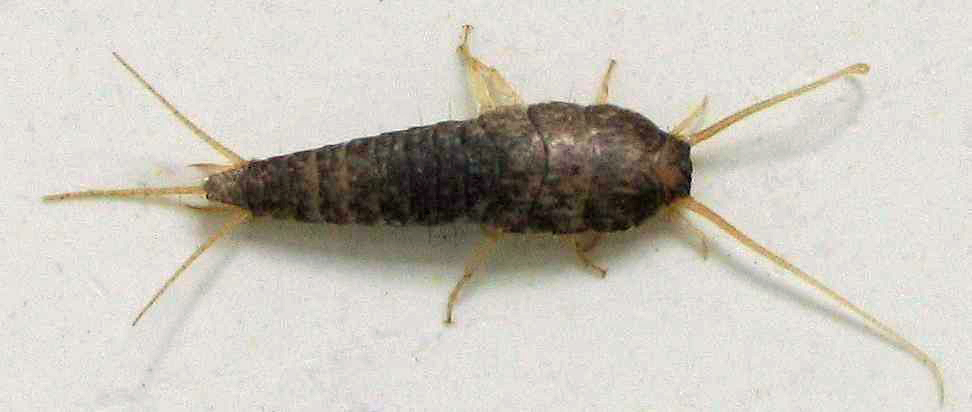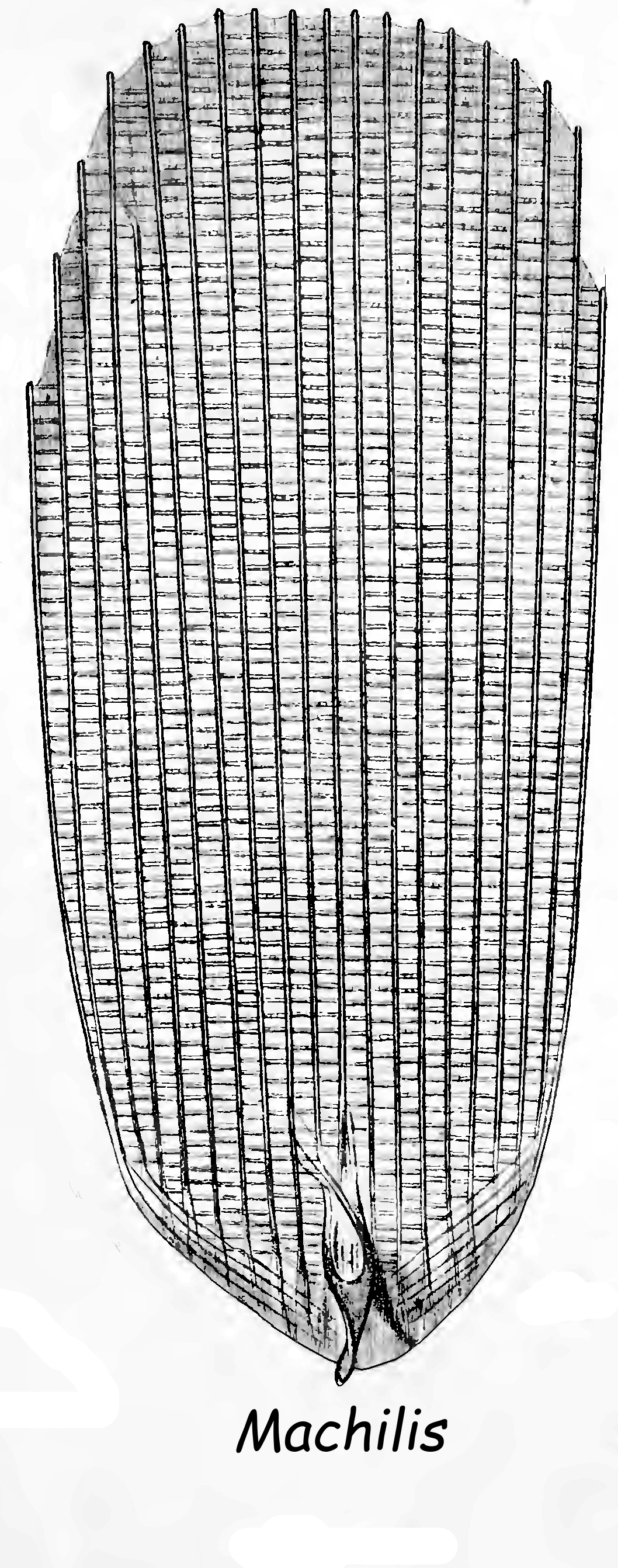|
Zygentoma
Zygentoma are an order in the class Insecta, and consist of about 550 known species. The Zygentoma include the so-called silverfish or fishmoths, and the firebrats. A conspicuous feature of the order are the three long caudal filaments. The two lateral filaments are cerci, and the medial one is an epiproct or ''appendix dorsalis''. In this they resemble the Archaeognatha, although the cerci of Zygentoma, unlike in the latter order, are nearly as long as the epiproct. Until the late twentieth century the Zygentoma were regarded as a suborder of the Thysanura, until it was recognized that the order Thysanura was paraphyletic, thus raising the two suborders to the status of independent monophyletic orders, with Archaeognatha as sister group to the Dicondylia, including the Zygentoma. Etymology The name "Zygentoma" is derived from the Greek ('), in context meaning "yoke" or "bridge"; and ('), "insects" (literally meaning "cut into", in reference to the segmented anatomy o ... [...More Info...] [...Related Items...] OR: [Wikipedia] [Google] [Baidu] |
Apterygota
The name Apterygota is sometimes applied to a former Subclass (biology), subclass of small, agile insects, distinguished from other insects by their lack of wings in the present and in their evolutionary history; notable examples are the silverfish, the firebrat, and the Archaeognatha, jumping bristletails. Their first known occurrence in the fossil record is during the Devonian period, 417–354 million years ago. The group Apterygota is not a clade; it is paraphyletic, and not recognized in modern classification schemes. As defined, the group contains two separate clades of wingless insects: Archaeognatha comprises jumping bristletails, while Zygentoma comprises silverfish and firebrats. The Zygentoma are in the clade Dicondylia with winged insects, a clade that includes all other insects, while Archaeognatha is sister to this lineage.A. Blanke, M. Koch, B. Wipfler, F. Wilde, B. Misof (2014) Head morphology of ''Tricholepidion gertschi'' indicates monophyletic Zygentoma. Frontiers ... [...More Info...] [...Related Items...] OR: [Wikipedia] [Google] [Baidu] |
Silverfish 2007-2
The silverfish (''Lepisma saccharinum'') is a species of small, primitive, wingless insect in the order Zygentoma (formerly Thysanura). Its common name derives from the insect's silvery light grey colour, combined with the fish-like appearance of its movements. The scientific name (''L. saccharinum'') indicates that the silverfish's diet consists of carbohydrates such as sugar or starches. While the common name ''silverfish'' is used throughout the global literature to refer to various species of Zygentoma, the Entomological Society of America restricts use of the term solely for ''Lepisma saccharinum''. Description The silverfish is a nocturnal insect typically long. Its abdomen tapers at the end, giving it a fish-like appearance. The newly hatched are whitish, but develop a greyish hue and metallic sheen as they get older. It has two long cerci and one terminal filament at the tip of the abdomen between the cerci. It also has two small compound eyes, although other members o ... [...More Info...] [...Related Items...] OR: [Wikipedia] [Google] [Baidu] |
Silverfish
The silverfish (''Lepisma saccharinum'') is a species of small, primitive, wingless insect in the order Zygentoma (formerly Thysanura). Its common name derives from the insect's silvery light grey colour, combined with the fish-like appearance of its movements. The scientific name (''L. saccharinum'') indicates that the silverfish's diet consists of carbohydrates such as sugar or starches. While the common name ''silverfish'' is used throughout the global literature to refer to various species of Zygentoma, the Entomological Society of America restricts use of the term solely for ''Lepisma saccharinum''. Description The silverfish is a nocturnal insect typically long. Its abdomen tapers at the end, giving it a fish-like appearance. The newly hatched are whitish, but develop a greyish hue and metallic sheen as they get older. It has two long cerci and one terminal filament at the tip of the abdomen between the cerci. It also has two small compound eyes, although other members ... [...More Info...] [...Related Items...] OR: [Wikipedia] [Google] [Baidu] |
Nicoletiidae
Nicoletiidae is a family of primitive insects belonging to the order Zygentoma. These insects live primarily underground, under detritus, or in caves. A few species are recorded as commensals inside nests of social insects, such as the species ''Allotrichotriura saevissima'' which lives inside fire ant nests. Nicoletiids lack eyes and they lack pigmentation. They have long antennae and terminal abdominal filaments. '' Coletinia'', a genus of this family, range in size between 10 and 15mm, and may have yellowish pigmentation but most species are transparent. Taxonomy This list encompasses the genera accepted by entomologist Luis Mendes. As with most taxonomy, not all the listed genera are accepted by all authorities, such as Catalogue of Life or Interim Register of Marine and Nonmarine Genera. * Atelurinae **'' Acanthinonychia'' Paclt, 1962 **'' Allatelura'' Silvestri, 1947 **'' Allograssiella'' Mendes & Schmidt, 2010 **'' Allomorphura'' Silvestri, 1916 **'' Allomorphuroides'' ... [...More Info...] [...Related Items...] OR: [Wikipedia] [Google] [Baidu] |
Archaeognatha
The Archaeognatha are an order of apterygotes, known by various common names such as jumping bristletails. Among extant insect taxa they are some of the most evolutionarily primitive; they appeared in the Middle Devonian period at about the same time as the arachnids. Specimens that closely resemble extant species have been found as both body and trace fossils (the latter including body imprints and trackways) in strata from the remainder of the Paleozoic Era and more recent periods. For historical reasons an alternative name for the order is Microcoryphia. Until the late 20th century the suborders Zygentoma and Archaeognatha comprised the order Thysanura; both orders possess three-pronged tails comprising two lateral cerci and a medial epiproct or ''appendix dorsalis''. Of the three organs, the appendix dorsalis is considerably longer than the two cerci; in this the Archaeognatha differ from the Zygentoma, in which the three organs are subequal in length. In the late 20th ... [...More Info...] [...Related Items...] OR: [Wikipedia] [Google] [Baidu] |
Maindroniidae
Maindroniidae is a very small family of silverfish, basal insects belonging to the order Zygentoma. It contains just a single genus, ''Maindronia'', and a handful of species. Four species of these insects are found in some of the driest deserts on Earth: in Sudan, the Arabian Peninsula, and the Atacama Desert on the west coast of Chile. The distribution of these closely related species suggests that ''Maindronia'' is a Gondwanan relict group. A new species in this family was recently discovered in Hormozgan province, Iran. ''Maindronia'' currently comprises four described species: * ''Maindronia bashagardensis'' Smith & Molero-Baltanás, 2020 – Iran * ''Maindronia beieri'' Schremmer, 1964 – Sudan * ''Maindronia mascatensis'' Bouvier, 1897 – Oman and UAE * ''Maindronia neotropicalis'' Bouvier, 1897 – Peru and Chile Recent findings from a phylogenetic study using the Cytochrome c oxidase subunit I and the 18S genes showed that ''Maindronia neotropicalis'', inhabiting ... [...More Info...] [...Related Items...] OR: [Wikipedia] [Google] [Baidu] |
Protrinemuridae
Protrinemuridae is a family of primitive insects belonging to the order Zygentoma. The family was previously classified as a subfamily of the Nicoletiidae Nicoletiidae is a family of primitive insects belonging to the order Zygentoma. These insects live primarily underground, under detritus, or in caves. A few species are recorded as commensals inside nests of social insects, such as the species ' ..., but raised to family level in 2002. The family comprises four genera: * '' Protrinemura'' Silvestri, 1942 * '' Protrinemurella'' Mendes, 2002 * '' Protrinemuroides'' Mendes, 2002 * '' Trinemophora'' Schaeffer, 1897 References {{Taxonbar, from=Q28432753 Zygentoma Insect families ... [...More Info...] [...Related Items...] OR: [Wikipedia] [Google] [Baidu] |
Insecta
Insects (from Latin ') are hexapod invertebrates of the class Insecta. They are the largest group within the arthropod phylum. Insects have a chitinous exoskeleton, a three-part body (head, thorax and abdomen), three pairs of jointed legs, compound eyes, and a pair of antennae. Insects are the most diverse group of animals, with more than a million described species; they represent more than half of all animal species. The insect nervous system consists of a brain and a ventral nerve cord. Most insects reproduce by laying eggs. Insects breathe air through a system of paired openings along their sides, connected to small tubes that take air directly to the tissues. The blood therefore does not carry oxygen; it is only partly contained in vessels, and some circulates in an open hemocoel. Insect vision is mainly through their compound eyes, with additional small ocelli. Many insects can hear, using tympanal organs, which may be on the legs or other parts of the body ... [...More Info...] [...Related Items...] OR: [Wikipedia] [Google] [Baidu] |
Thysanura
Thysanura is the now Deprecation, deprecated name of what was, for over a century, recognised as an Order (biology), order in the Class (biology), class Insecta. The two constituent groups within the former order, the Archaeognatha (jumping bristletails) and the Zygentoma (silverfish and firebrats), share several characteristics, such as of having three long caudal filaments, the lateral ones being the Cercus, cerci, while the one between (telson) is a Anatomical terms of location#Medial and lateral, medial cerciform appendage, specifically an epiproct. They are also both wingless, and have bodies covered with fine scales, rather like the scales of the practically unrelated Lepidoptera. In the late 20th century, it was recognized that the two suborders were not sister taxa, therefore Thysanura was paraphyletic, and the two suborders were each raised to the status of an independent monophyletic order, with Archaeognatha sister taxon to the Dicondylia, including the Zygentoma. Althou ... [...More Info...] [...Related Items...] OR: [Wikipedia] [Google] [Baidu] |
Atelura Formicaria
''Atelura formicaria'' is a species of nicoletiid in the family Nicoletiidae Nicoletiidae is a family of primitive insects belonging to the order Zygentoma. These insects live primarily underground, under detritus, or in caves. A few species are recorded as commensals inside nests of social insects, such as the species ' .... References Further reading * Zygentoma Articles created by Qbugbot Insects described in 1855 {{Zygentoma-stub ... [...More Info...] [...Related Items...] OR: [Wikipedia] [Google] [Baidu] |
Lepismatidae
Lepismatidae is a family of primitive wingless insects with about 340 described species. This family contains the two most familiar members of the order Zygentoma: the silverfish (''Lepisma saccharinum'') and the firebrat (''Thermobia domestica''). It is one of five families in the order Zygentoma. Lepismatids are elongated, flattened insects, the majority of which are scavengers. The abdomen is usually clothed in tiny scale (zoology), scales and terminates with three "tails" of roughly equal length. The compound eyes are small and well separated. They typically live in warm, damp environments, including indoors. They avoid light. Genera These subfamilies and genera belong to the family Lepismatidae: *Acrotelsinae Mendes, 1991 **''Acrotelsa'' Escherich, 1905 **''Anisolepisma'' Paclt, 1967 **''Desertinoma'' Kaplin, 1992 **''Lepismina'' Gervais, 1844 **''Paracrotelsa'' Paclt, 1967 **''Primacrotelsa'' Mendes, 2004 *Ctenolepismatinae Mendes, 1991 **''Acrotelsella'' Silvestri, 1935 ... [...More Info...] [...Related Items...] OR: [Wikipedia] [Google] [Baidu] |
Pterygota
Pterygota ( ) is a subclass of insects that includes all winged insects and groups who lost them secondarily. Pterygota group comprises 99.9% of all insects. The orders not included are the Archaeognatha (jumping bristletails) and the Zygentoma ( silverfishes and firebrats), two primitively wingless insect orders. Unlike Archaeognatha and Zygentoma, the pterygotes do not have styli or vesicles on their abdomen (also absent in some zygentomans), and with the exception of the majority of mayflies, are also missing the median terminal filament which is present in the ancestrally wingless insects. The oldest known representatives of the group appeared during the mid-Carboniferous, around 328–324 million years ago, and the group subsequently underwent rapid diversification. Claims that they originated substantially earlier during the Silurian or Devonian based on molecular clock estimates are unlikely based on the fossil record, and are likely analytical artefacts. __TOC__ Sys ... [...More Info...] [...Related Items...] OR: [Wikipedia] [Google] [Baidu] |




